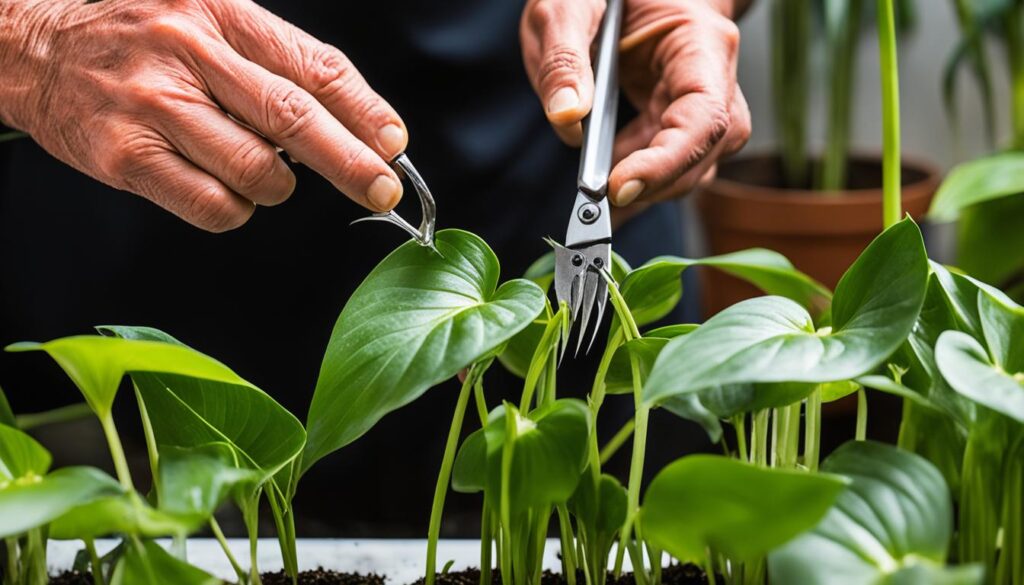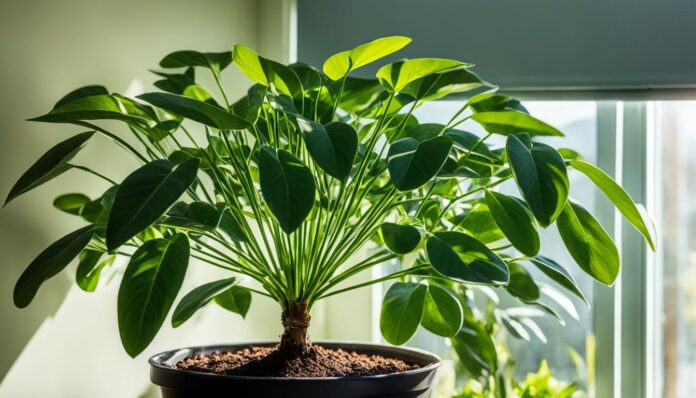The Ace of Spades plant, scientifically known as Anthurium Ace of Spades, is a sought-after species among collectors of rare tropical plants. This evergreen plant features stunning heart-shaped leaves with a velvety texture and striking dark green color. It is low-maintenance and can be grown indoors with relative ease. However, it requires specific care to thrive and reach its full potential.
Key Takeaways:
- The Ace of Spades plant, also known as Anthurium Ace of Spades, is a rare tropical plant with striking dark green heart-shaped leaves.
- It is relatively easy to care for and can be grown as a houseplant.
- The plant thrives in bright shade or indirect sunlight and requires regular watering and high humidity levels.
- Propagation can be done through plantlets or root divisions.
- There are different varieties of the Ace of Spades plant, including the Ace of Spades Black with black leaves.
What Are These Rare Plants
The Ace of Spades plant, belonging to the Anthurium genus, is highly coveted among tropical collectors for its uniqueness and captivating charm. Its distinct foliage sets it apart as a rare plant, especially sought after by enthusiasts in the tropical collector’s group.
The Ace of Spades plant showcases heart-shaped leaves adorned with silver-white venation against its deep green foliage, creating a striking visual appeal. This hybrid variety’s parentage remains unknown, adding to its allure and mystique among plant enthusiasts.
“Rare plants like the Ace of Spades serve as prized possessions for tropical collectors and plant aficionados alike. Their uniqueness and scarcity make them incredibly desirable additions to any collection.”
Comparison of Rare Plants and Their Desirability
| Plant Name | Uniqueness | Variegation | Color | Desirability |
|---|---|---|---|---|
| Ace of Spades | High | Silver-white venation | Dark green | Very desirable |
| Black Anthurium Ace of Spades | Moderate | Black leaves | Dark green | Highly desirable |
| Anthurium villenaorum | Low | Creamy white venations | Varied colors | Moderately desirable |
These rare plants hold significant value and play a vital role in enhancing the beauty and diversity of tropical plant collections. Their limited availability and distinctive features contribute to their desirability, making them prized possessions for plant enthusiasts.
Anthurium Ace of Spades Plant Care
The Anthurium Ace of Spades plant is a stunning tropical plant that can be easily cared for, even by those without extensive gardening experience. Here are some essential tips to ensure the health and growth of your Anthurium Ace of Spades:
- Potting Mix: Use a well-draining potting mix for your Anthurium Ace of Spades. A mixture of sterile garden compost with broken walnut shells or brick bits of charcoal is recommended. Alternatively, you can use orchid soil mixed with perlite and gravel.
- Light Requirements: The Ace of Spades plant thrives in bright shade or indirect sunlight. It should be placed in a location where it can receive adequate light without being exposed to direct sunlight, which can cause leaf burn.
- Watering: Regular watering is essential for the Anthurium Ace of Spades, especially during the growing season. Keep the soil evenly moist but avoid overwatering, as it can lead to root rot. Allow the top inch of the soil to dry out before watering again.
- Temperature and Humidity: The Ace of Spades plant prefers temperatures between 65 to 75°F (15 to 24°C). It thrives in high humidity levels, so misting the leaves regularly or placing the plant on a humidity tray can help create a suitable environment.
- Fertilizing and Pruning: Feed your Anthurium Ace of Spades plant with a balanced fertilizer every two months during the growing season. Prune any dead or yellowing leaves to maintain a tidy appearance and promote new growth.
By following these care instructions, you can ensure that your Anthurium Ace of Spades plant remains healthy and vibrant, adding a touch of beauty to your indoor space.
Propagation of Anthurium Ace of Spades

The Anthurium Ace of Spades plant can be propagated through plantlets or root divisions. Plantlets, also known as suckers or offsets, are small plants that grow attached to the base of the mature plant. During the growing season, these plantlets can be carefully separated from the parent plant and potted individually. They will develop their own root system and continue to grow independently.
Root division is another effective method of propagation for the Anthurium Ace of Spades. To propagate via root division, carefully remove the plant from its pot, ensuring not to damage the roots. Divide the root mass into two equal halves, making sure that each half has enough roots to sustain growth. Plant each divided section separately, providing a suitable potting mix and ensuring proper drainage.
Both these propagation methods offer reliable ways to expand your Anthurium Ace of Spades plant collection. It’s essential to provide the propagated plants with a moist environment and high humidity to aid in their establishment and growth. Maintain a consistent care routine, including watering, light requirements, and fertilization, to ensure their healthy development.
Propagation Methods Summary:
| Propagation Method | Description |
|---|---|
| Plantlets | Separate small plants that grow attached to the base of the mature plant |
| Root Division | Divide the root mass into two halves and plant each half separately |
By utilizing these propagation techniques, you can expand your Anthurium Ace of Spades collection and share the beauty of this unique plant with others.
Anthurium Ace of Spades Varieties
The Anthurium Ace of Spades plant offers a range of varieties, each with unique characteristics and appearances. One highly sought-after variety is the Ace of Spades Black. This stunning plant showcases mesmerizing black leaves and heart-shaped foliage that resembles the spade symbol found on playing cards. The Ace of Spades Black is a striking addition to any indoor garden, adding a touch of elegance and drama.
Another captivating variety of the Anthurium Ace of Spades is the Anthurium villenaorum. This particular variety features variegated leaves adorned with creamy white venations, creating a beautiful contrast against the deep green foliage. The Anthurium villenaorum is a true beauty that captivates plant enthusiasts with its unique and eye-catching appearance.
One distinct species among the Anthurium Ace of Spades varieties is the Anthurium pedatoradiatum. This species stands out with its distinct leaves that differ from the typical Ace of Spades plant. With its unusual leaf shape and texture, the Anthurium pedatoradiatum adds intrigue and diversity to any collection of Anthurium plants.
These various Anthurium Ace of Spades varieties, including the Ace of Spades Black, Anthurium villenaorum, and Anthurium pedatoradiatum, contribute to the appeal and desirability of this exceptional plant among plant enthusiasts. Each variety offers a unique and stunning appearance, allowing collectors to enjoy a diverse display of beauty in their indoor gardens.
FAQ
What is the scientific name of the Ace of Spades plant?
The scientific name of the Ace of Spades plant is Anthurium Ace of Spades.
Why is the Ace of Spades plant considered rare?
The Ace of Spades plant is considered rare because of its striking appearance and dark green color, making it highly sought-after among collectors of tropical plants.
How do I care for an Anthurium Ace of Spades plant?
To care for an Anthurium Ace of Spades plant, ensure it is grown in a well-draining potting mix, provide bright shade or indirect sunlight, water regularly, maintain temperatures between 65 to 75°F (15 to 24°C), and provide high humidity levels. Fertilizing with a balanced feed and occasional pruning are also recommended.
How can I propagate an Anthurium Ace of Spades plant?
The Anthurium Ace of Spades plant can be propagated through plantlets or root divisions. Plantlets can be separated from the bottom stem of the mature plant and potted individually. Root division involves carefully dividing the plant’s roots into halves and planting them separately.
Are there different varieties of the Anthurium Ace of Spades plant?
Yes, there are different varieties of the Anthurium Ace of Spades plant. One popular variety is the Ace of Spades Black, which has black leaves resembling the spade on playing cards. Another variety is the Anthurium villenaorum, which features variegated leaves with creamy white venations. The Anthurium pedatoradiatum is a distinct species with unique leaves.

